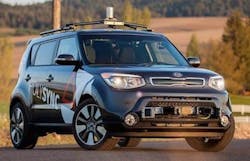Self-Driving Cars Require Shift from Message-Centric to Data-Centric Computing Strategies
America is getting ready for the advent of self-driving vehicles. This past month, it was reported that Virginia is setting up “automated corridors” on 70 miles of highway for the testing of this swiftly approaching technology.
That state is not alone. California, Nevada, Michigan, Florida and Washington, D.C. have all given the nod to autonomous vehicle testing on portions of their roadways. Robotics company Harbrick has been working with legislators in Idaho to do the same.
Harbrick, an autonomous-vehicle innovator based in northern Idaho, is doing far more than just talking to state lawmakers. The company is working on technologies to speed the progress of bringing self-driving cars to market. Its PolySync solution is the world’s first out-of-box operating system for autonomous vehicles.
One of the daunting challenges in this field involves the centralizing of computing architectures. Instead of spreading around multiple computers that work independently, developers of self-driving technology must find ways to create a single brain that does many things. Autonomous vehicles call for a kind of “nerve center.” In principle, this is similar to the way a smart phone operates, with the combined capabilities of calling, computing, taking photos, accessing the Internet, and interacting with apps. All from a single source.
That’s where the PolySync operating system comes in. It provides a plug-and-play network of software, including sensors, actuators and multiple applications – all capable of interacting with any new apps released by automakers. For automakers, suppliers, and startups building automated vehicle technology, PolySync offers a common, consistent platform to develop software for multiple vehicles. It provides a robust back end infrastructure that facilitates fast deployment, functional safety, and cybersecurity.
To deliver this flexibility and power, PolySync relies on an advanced Internet of Things (IoT) data-sharing backbone: PrismTech’s Vortex. It handles all the data interfaces within the system, optimizing and making the vast amounts of information accessible. Vortex is based on the Data Distribution Service (DDS), an OMG open standard that serves as a protocol for the manifold Industrial IoT technologies. DDS helps centralize computing power by enabling real-time data sharing with support for device-to-device, device-to-cloud and cloud-to-cloud configurations.
See PrismTech breakout sessions at Smart Industry 2015:
- Bridging the IT/OT Divide: Field-to-cloud Implementations
- Buy or Build? Gain Scale and Speed with IIoT Platforms & Services
Vortex and its underlying DDS standard have helped boost Harbrick’s efficiency by a considerable measure. For example, it has eliminated the need for debugging by as much as 52 percent and has allowed the company to focus all its efforts on its core value: enabling easy and safe automated vehicle software development.
All of that computing power, bandwidth and sophistication will be necessary as these vehicles come to market. Functions such as staying in the correct lane, keeping a safe distance from other vehicles, and stopping for pedestrians will require immense amounts of data coordination. The quantities of input a human brain processes while making the simplest maneuvers behind the wheel of a standard vehicle are unfathomable. This poses an ongoing challenge for those companies trying to duplicate such complex functions.
And so, as states begin setting up special accommodations for self-driving vehicles, innovative companies will continue working behind the scenes to make the future possible. By expanding bandwidth, centralizing computer functions and simplifying data sharing, these companies are hastening the day of the self-driving revolution.
It’s getting closer.
Read more Smart Industry Connect blogs from PrismTech.
Spiros N. Motsenigos serves as vice president, sales US, for PrismTech. He leads a team pushing the boundaries of mission critical messaging infrastructure for Industrial Internet and more broadly Internet of Things (IoT) applications including transportation and medical devices through to smart cities and smart grid.






